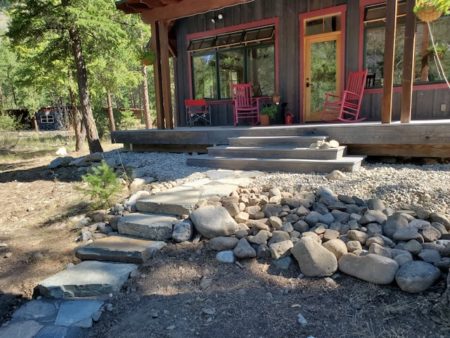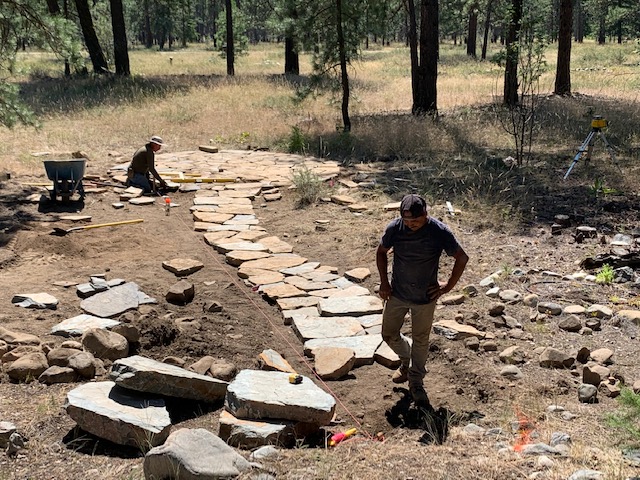The temperatures topped 100 Fahrenheit week (38+ Centigrade) up at the mountain cabin one day last week. The three-man yardscape crew seemed indifferent. They spent their first afternoon prepping the site; they dumped mounds of dusty gravel, unloaded heavy flagstones from a flatbed, cut suffocating strips of black weed mesh and pounded guide posts into the rocky soil — all in the hottest part of the day. On the second day, they pulled in a few minutes after 7 a.m. and didn’t pull out again until a few minutes after 5 p.m.; they took one 20-minute break for lunch in the shade of their pickup. They finished a little after noon on the third day, only to hop back in their crew-cab pickup and head to another — and much bigger — job.
The entire time they were at my place, they worked at a steady pace without flagging or complaining or even breathing heavily.
I spent most of that time inside, slumped in front of a couple of outmatched fans, a wet towel draped around my neck. It was too hot to clean, nap or eat. I gave up typing when my laptop grew hot to the touch. So mostly I looked out the window, watching a patch of my scabby land get transformed.
Along the way, I realized I was watching the story process at work.
Deconstructing the creative process
I’ll circle back in a bit to connect those dots more literally. For now, picture the creation process I witnessed:
One of the workers manned the orange Kubota, scooping and moving and dumping and then hand-raking gravel in a four-foot ribbons around the perimeter of the cabin and garage. That’s after he scraped away the existing stones and set down weed-barrier fabric that he measured and cut to fit. (I was warned the weeds will come back, but not for awhile and fewer of them. Even then, I’ll have better protection from wildfire sparks torching the cabin).
The other two shoveled a rough path of sand out from the front of the cabin, smoothed it and placed the flagstones. To say they “placed” the stones does not do their process justice. They puzzled out how the rough-edged stones fit together, sometimes trying three or four before they were satisfied. They had to work with the materials available — stacks of stone that varied in size and shape — but also with an end in mind: a gently curving path leading out to a circular patio in a clearing. They had to make the surface stable and somewhat level so I wouldn’t trip on my nighttime forays out to watch the stars.
While one focused on fitting the stones in a pattern, a few feet at a time, the other worked on his knees with a hand trowel. He dug sand from the designated space, placed the stone, tested it with a long level, pulled out the stone, dug out or added more sand, put the stone back, tested the level again. Often he would do this four or five times before he was satisfied. Only then would he take a length of 6-by-6, lay it along the stone and pound it secure with a mallet. Then he would check the level again. I never saw him scowl or heard him grumble. He whistled along with his Spanish-language music station, smiled when I walked out to hand him some cold water, blushed and shook his head that, no, he didn’t need the baño, and kept working.

The last morning, the Kubota driver sharpened the edges of the gravel perimeter. He used leftover gravel to fill in thin spots and add a perimeter — not part of the paid job order — around a small woodshed. Out front, the two men used pickaxes and shovels to dig out four steps leading down from the cabin porch to the path. Then they wrestled giant flagstones — I bet each weighed more than either of them — and made four gorgeous, level, sturdy stairs. One got back on his knees and grouted the flagstones with sand. The other came behind to sweep and wash and resweep and rewash the stones, revealing marbles of gold and orange and rust I didn’t know were there. As all three cleaned the property of their construction debris, they grabbed loosened rocks and tossed them in pleasing piles edging the top of the path.
And there it was, a story made from stone!
Building stories
Still not seeing it? Imagine it again, subbing the soft materials of ideas and words for sand and gravel. Just as a journalist does — or should do — when constructing a story, the yardscape crew worked through a series of essential steps:
- Determine a purpose. (For my yard work, a path out to a patio for stargazing. For a story, maybe it’s a straightforward news report that provides clear information, an investigation that exposes wrong, or a narrative that takes readers on an experiential journey.)
- Envision what's needed to support that purpose. (The yardscape crew needed to know what materials and expertise they would need to work in my challenging land — and I needed to know what I could afford. For a story, you need to identify sources — both people and records — determine if they are available in the time you have. You also need to consider expertise — graphics, photography, a data-base specialist? And, of course, figure out your deadline and budget.)
- Collect your material. (The yardscapers brought in a dump truck of gravel, a flatbed of flagstone, weed mesh, that cute orange Kubota and all manner of tools. Your story will need interviews, data, maybe on-scene observation. Just as they filled my yard with the stuff of the project, you need to fill your notebook with the stuff of story.)
- Outline. (The yard crew walked, eyeballed and measured the site, envisioning where they would put what. Story outlines come in many forms, but it’s the same process: Imagine where you would start, how you would move forward, where you would end. Along the way, figure out if you’re missing anything.)
- Write a rough first draft. (The gravel was shoved close to where it belonged; the flagstones were laid out in a decent, but not finished, pattern. So many of us, when we write, labor to perfect things sentence by sentence rather than making fast, effective work of getting it all down in a decent, but not finished, piece.)
- Write the real thing. (This is where the gravel was evened out and the stones were set and pounded into their permanent place. This is where you secure your lede, rearrange a few sections, tighten down to a faster, more sure ending. And just as the setter didn’t take shortcuts at leveling the stones, don’t take shortcuts with your nut graf.)
- Polish. (Gravel edges were tidied. Small stones were set into small gaps and tested with weight. Grout was worked into the seams. In story language, the work was being checked for flow, accuracy, style, grammar and consistency.)
- Hit SEND. (Fire up your reporter’s pickup and head onto the next story. But don’t forget to check in with the editor and story sources — the clients. If all is good, take a moment to survey your work over breakfast with coffee, or under the stars with a glass of chilled wine.)
Find your own metaphorical method
My childhood was surrounded by patterns and blueprints. My father built the house I grew up in and much of the furniture; my mother sewed and knitted; my brothers became engineers who do woodworking as an avocation. It took me a long, painful time to think of stories as things that are constructed — not just created through the divine intervention of some finicky muse.
If the metaphor doesn’t work for you, find your own. Maybe it helps you to think of stories as various forms of music, or as movies, or as planning and planting a garden. Each yields in a unique result. But all result, at core, from a similar process.



